Clinical Leadership in Healthcare Settings: Analysis of Past Studies
VerifiedAdded on 2023/06/03
|9
|2257
|389
Literature Review
AI Summary
This literature review analyzes clinical leadership in healthcare settings based on several past studies. It examines the impact of including clinical leaders on hospital governing boards, the development of clinical leadership interventions for frontline healthcare providers, governance gaps in rural healthcare, and the importance of a calm and confident approach in mental health nursing. The review highlights the positive effects of clinical leadership on patient experience, service quality, and the work environment for healthcare providers. It also identifies areas for further research, such as the long-term outcomes of clinical leadership interventions and the development of necessary skills for handling challenging situations in clinical settings. The discussed studies collectively emphasize the need for healthcare organizations to prioritize and invest in effective clinical leadership to improve overall healthcare delivery and patient outcomes. Desklib offers more solved assignments and study resources for students.
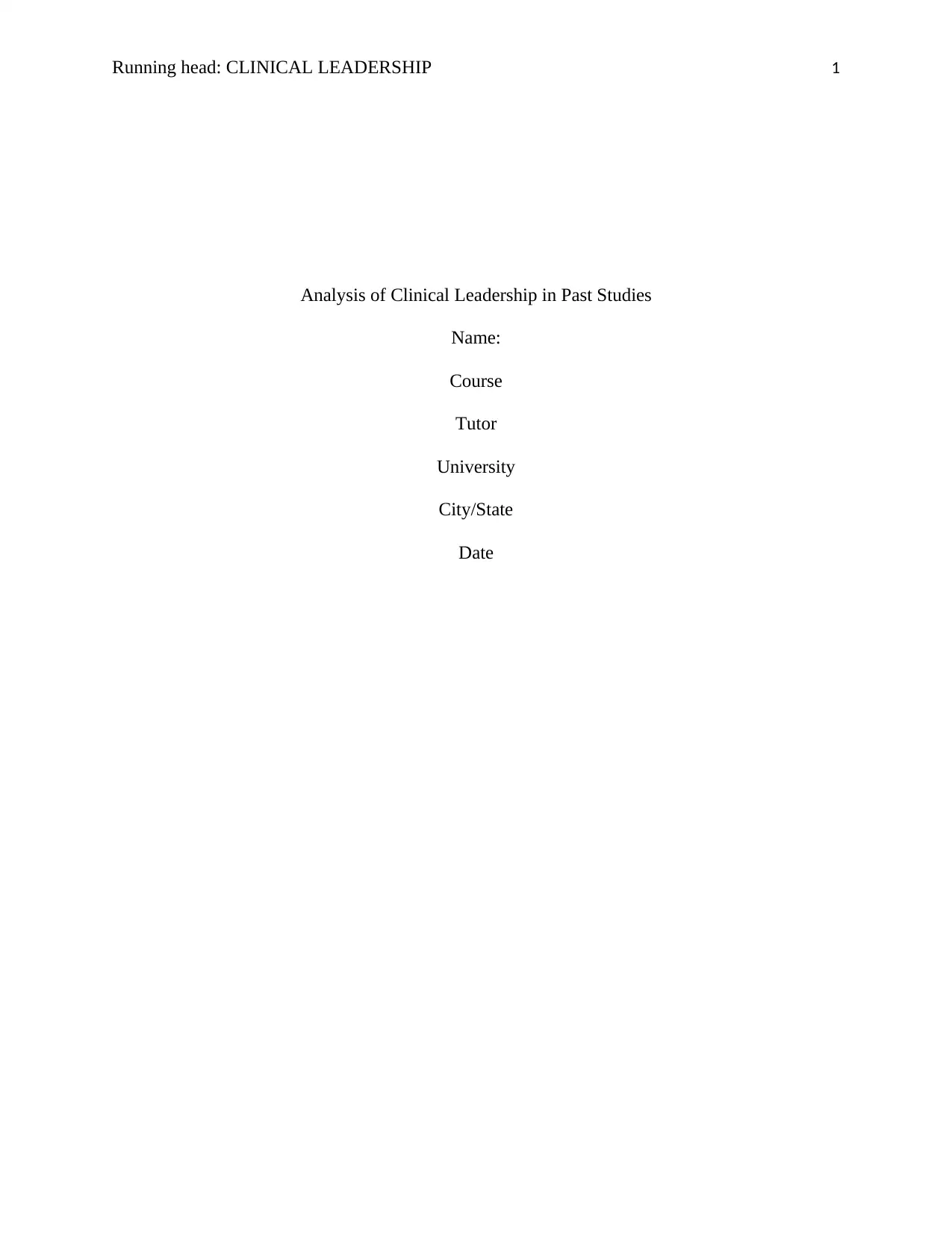
Running head: CLINICAL LEADERSHIP 1
Analysis of Clinical Leadership in Past Studies
Name:
Course
Tutor
University
City/State
Date
Analysis of Clinical Leadership in Past Studies
Name:
Course
Tutor
University
City/State
Date
Paraphrase This Document
Need a fresh take? Get an instant paraphrase of this document with our AI Paraphraser
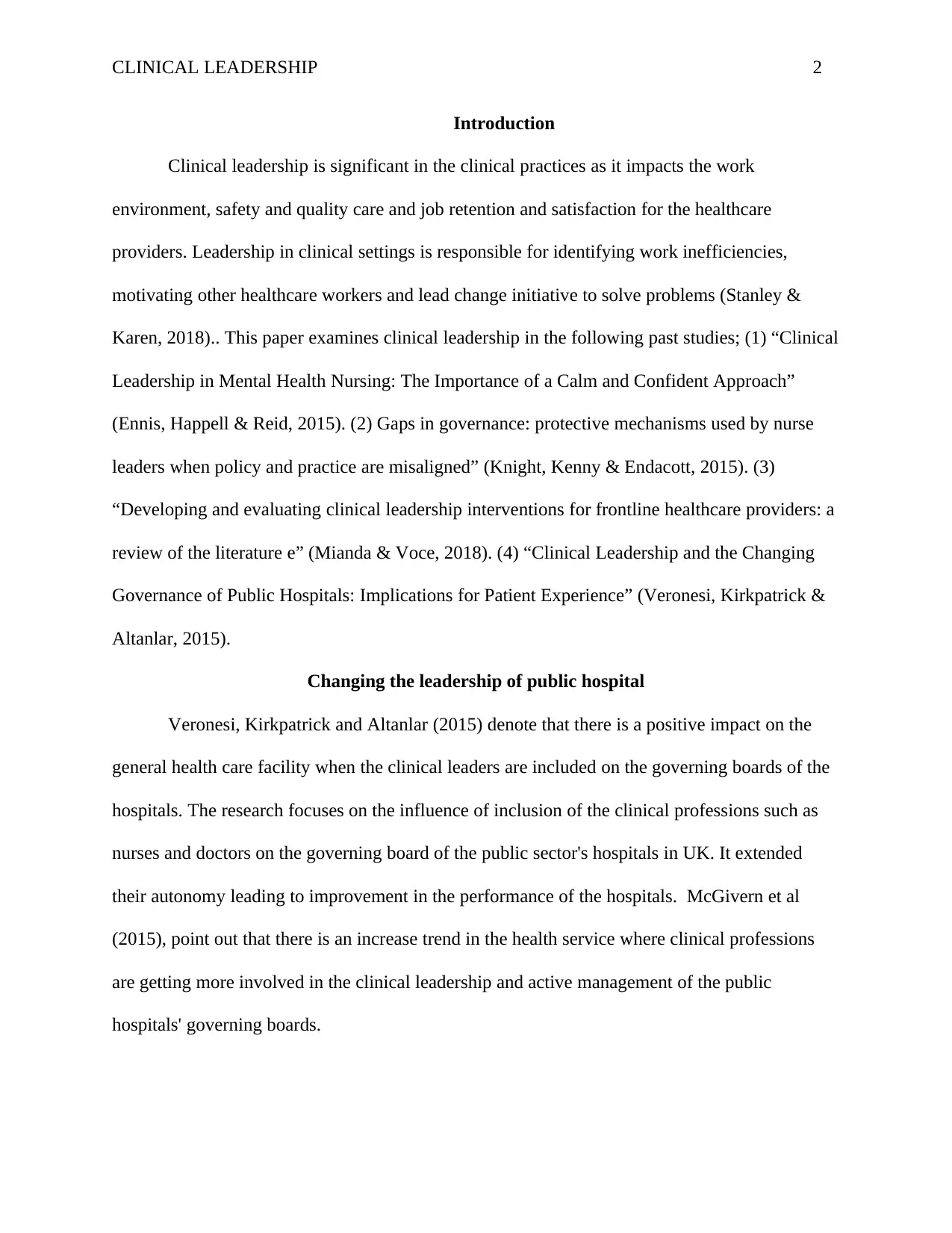
CLINICAL LEADERSHIP 2
Introduction
Clinical leadership is significant in the clinical practices as it impacts the work
environment, safety and quality care and job retention and satisfaction for the healthcare
providers. Leadership in clinical settings is responsible for identifying work inefficiencies,
motivating other healthcare workers and lead change initiative to solve problems (Stanley &
Karen, 2018).. This paper examines clinical leadership in the following past studies; (1) “Clinical
Leadership in Mental Health Nursing: The Importance of a Calm and Confident Approach”
(Ennis, Happell & Reid, 2015). (2) Gaps in governance: protective mechanisms used by nurse
leaders when policy and practice are misaligned” (Knight, Kenny & Endacott, 2015). (3)
“Developing and evaluating clinical leadership interventions for frontline healthcare providers: a
review of the literature e” (Mianda & Voce, 2018). (4) “Clinical Leadership and the Changing
Governance of Public Hospitals: Implications for Patient Experience” (Veronesi, Kirkpatrick &
Altanlar, 2015).
Changing the leadership of public hospital
Veronesi, Kirkpatrick and Altanlar (2015) denote that there is a positive impact on the
general health care facility when the clinical leaders are included on the governing boards of the
hospitals. The research focuses on the influence of inclusion of the clinical professions such as
nurses and doctors on the governing board of the public sector's hospitals in UK. It extended
their autonomy leading to improvement in the performance of the hospitals. McGivern et al
(2015), point out that there is an increase trend in the health service where clinical professions
are getting more involved in the clinical leadership and active management of the public
hospitals' governing boards.
Introduction
Clinical leadership is significant in the clinical practices as it impacts the work
environment, safety and quality care and job retention and satisfaction for the healthcare
providers. Leadership in clinical settings is responsible for identifying work inefficiencies,
motivating other healthcare workers and lead change initiative to solve problems (Stanley &
Karen, 2018).. This paper examines clinical leadership in the following past studies; (1) “Clinical
Leadership in Mental Health Nursing: The Importance of a Calm and Confident Approach”
(Ennis, Happell & Reid, 2015). (2) Gaps in governance: protective mechanisms used by nurse
leaders when policy and practice are misaligned” (Knight, Kenny & Endacott, 2015). (3)
“Developing and evaluating clinical leadership interventions for frontline healthcare providers: a
review of the literature e” (Mianda & Voce, 2018). (4) “Clinical Leadership and the Changing
Governance of Public Hospitals: Implications for Patient Experience” (Veronesi, Kirkpatrick &
Altanlar, 2015).
Changing the leadership of public hospital
Veronesi, Kirkpatrick and Altanlar (2015) denote that there is a positive impact on the
general health care facility when the clinical leaders are included on the governing boards of the
hospitals. The research focuses on the influence of inclusion of the clinical professions such as
nurses and doctors on the governing board of the public sector's hospitals in UK. It extended
their autonomy leading to improvement in the performance of the hospitals. McGivern et al
(2015), point out that there is an increase trend in the health service where clinical professions
are getting more involved in the clinical leadership and active management of the public
hospitals' governing boards.
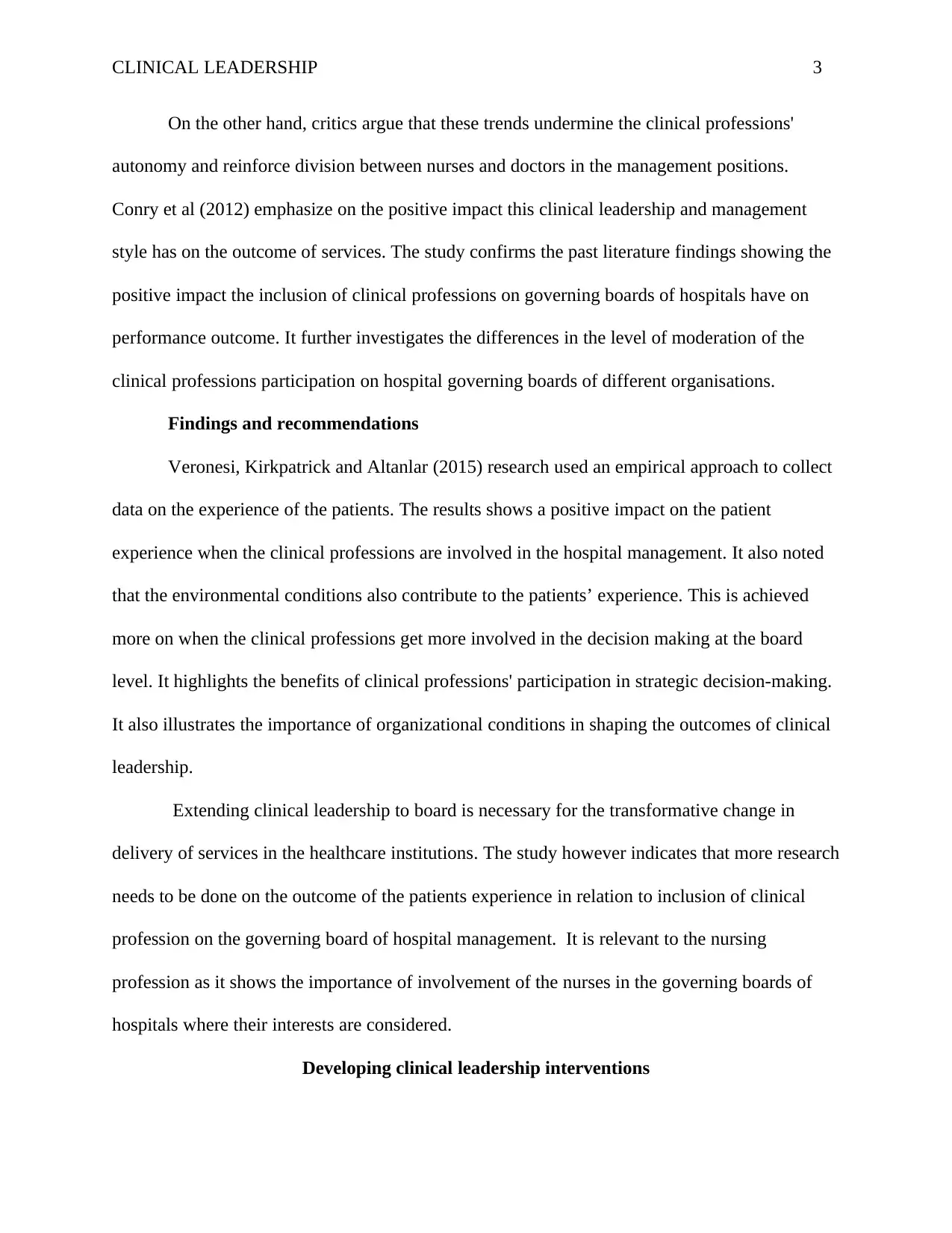
CLINICAL LEADERSHIP 3
On the other hand, critics argue that these trends undermine the clinical professions'
autonomy and reinforce division between nurses and doctors in the management positions.
Conry et al (2012) emphasize on the positive impact this clinical leadership and management
style has on the outcome of services. The study confirms the past literature findings showing the
positive impact the inclusion of clinical professions on governing boards of hospitals have on
performance outcome. It further investigates the differences in the level of moderation of the
clinical professions participation on hospital governing boards of different organisations.
Findings and recommendations
Veronesi, Kirkpatrick and Altanlar (2015) research used an empirical approach to collect
data on the experience of the patients. The results shows a positive impact on the patient
experience when the clinical professions are involved in the hospital management. It also noted
that the environmental conditions also contribute to the patients’ experience. This is achieved
more on when the clinical professions get more involved in the decision making at the board
level. It highlights the benefits of clinical professions' participation in strategic decision-making.
It also illustrates the importance of organizational conditions in shaping the outcomes of clinical
leadership.
Extending clinical leadership to board is necessary for the transformative change in
delivery of services in the healthcare institutions. The study however indicates that more research
needs to be done on the outcome of the patients experience in relation to inclusion of clinical
profession on the governing board of hospital management. It is relevant to the nursing
profession as it shows the importance of involvement of the nurses in the governing boards of
hospitals where their interests are considered.
Developing clinical leadership interventions
On the other hand, critics argue that these trends undermine the clinical professions'
autonomy and reinforce division between nurses and doctors in the management positions.
Conry et al (2012) emphasize on the positive impact this clinical leadership and management
style has on the outcome of services. The study confirms the past literature findings showing the
positive impact the inclusion of clinical professions on governing boards of hospitals have on
performance outcome. It further investigates the differences in the level of moderation of the
clinical professions participation on hospital governing boards of different organisations.
Findings and recommendations
Veronesi, Kirkpatrick and Altanlar (2015) research used an empirical approach to collect
data on the experience of the patients. The results shows a positive impact on the patient
experience when the clinical professions are involved in the hospital management. It also noted
that the environmental conditions also contribute to the patients’ experience. This is achieved
more on when the clinical professions get more involved in the decision making at the board
level. It highlights the benefits of clinical professions' participation in strategic decision-making.
It also illustrates the importance of organizational conditions in shaping the outcomes of clinical
leadership.
Extending clinical leadership to board is necessary for the transformative change in
delivery of services in the healthcare institutions. The study however indicates that more research
needs to be done on the outcome of the patients experience in relation to inclusion of clinical
profession on the governing board of hospital management. It is relevant to the nursing
profession as it shows the importance of involvement of the nurses in the governing boards of
hospitals where their interests are considered.
Developing clinical leadership interventions
⊘ This is a preview!⊘
Do you want full access?
Subscribe today to unlock all pages.

Trusted by 1+ million students worldwide
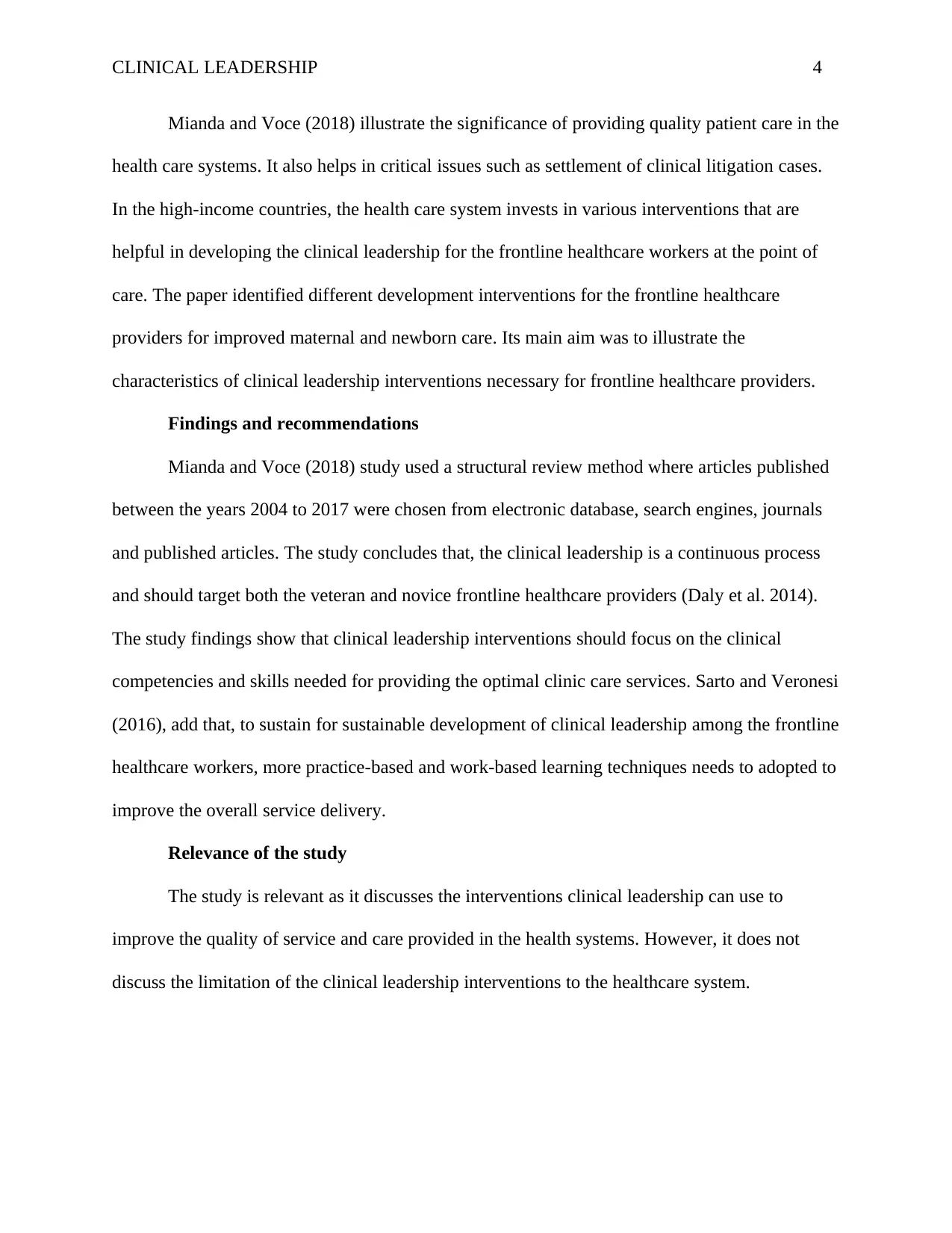
CLINICAL LEADERSHIP 4
Mianda and Voce (2018) illustrate the significance of providing quality patient care in the
health care systems. It also helps in critical issues such as settlement of clinical litigation cases.
In the high-income countries, the health care system invests in various interventions that are
helpful in developing the clinical leadership for the frontline healthcare workers at the point of
care. The paper identified different development interventions for the frontline healthcare
providers for improved maternal and newborn care. Its main aim was to illustrate the
characteristics of clinical leadership interventions necessary for frontline healthcare providers.
Findings and recommendations
Mianda and Voce (2018) study used a structural review method where articles published
between the years 2004 to 2017 were chosen from electronic database, search engines, journals
and published articles. The study concludes that, the clinical leadership is a continuous process
and should target both the veteran and novice frontline healthcare providers (Daly et al. 2014).
The study findings show that clinical leadership interventions should focus on the clinical
competencies and skills needed for providing the optimal clinic care services. Sarto and Veronesi
(2016), add that, to sustain for sustainable development of clinical leadership among the frontline
healthcare workers, more practice-based and work-based learning techniques needs to adopted to
improve the overall service delivery.
Relevance of the study
The study is relevant as it discusses the interventions clinical leadership can use to
improve the quality of service and care provided in the health systems. However, it does not
discuss the limitation of the clinical leadership interventions to the healthcare system.
Mianda and Voce (2018) illustrate the significance of providing quality patient care in the
health care systems. It also helps in critical issues such as settlement of clinical litigation cases.
In the high-income countries, the health care system invests in various interventions that are
helpful in developing the clinical leadership for the frontline healthcare workers at the point of
care. The paper identified different development interventions for the frontline healthcare
providers for improved maternal and newborn care. Its main aim was to illustrate the
characteristics of clinical leadership interventions necessary for frontline healthcare providers.
Findings and recommendations
Mianda and Voce (2018) study used a structural review method where articles published
between the years 2004 to 2017 were chosen from electronic database, search engines, journals
and published articles. The study concludes that, the clinical leadership is a continuous process
and should target both the veteran and novice frontline healthcare providers (Daly et al. 2014).
The study findings show that clinical leadership interventions should focus on the clinical
competencies and skills needed for providing the optimal clinic care services. Sarto and Veronesi
(2016), add that, to sustain for sustainable development of clinical leadership among the frontline
healthcare workers, more practice-based and work-based learning techniques needs to adopted to
improve the overall service delivery.
Relevance of the study
The study is relevant as it discusses the interventions clinical leadership can use to
improve the quality of service and care provided in the health systems. However, it does not
discuss the limitation of the clinical leadership interventions to the healthcare system.
Paraphrase This Document
Need a fresh take? Get an instant paraphrase of this document with our AI Paraphraser
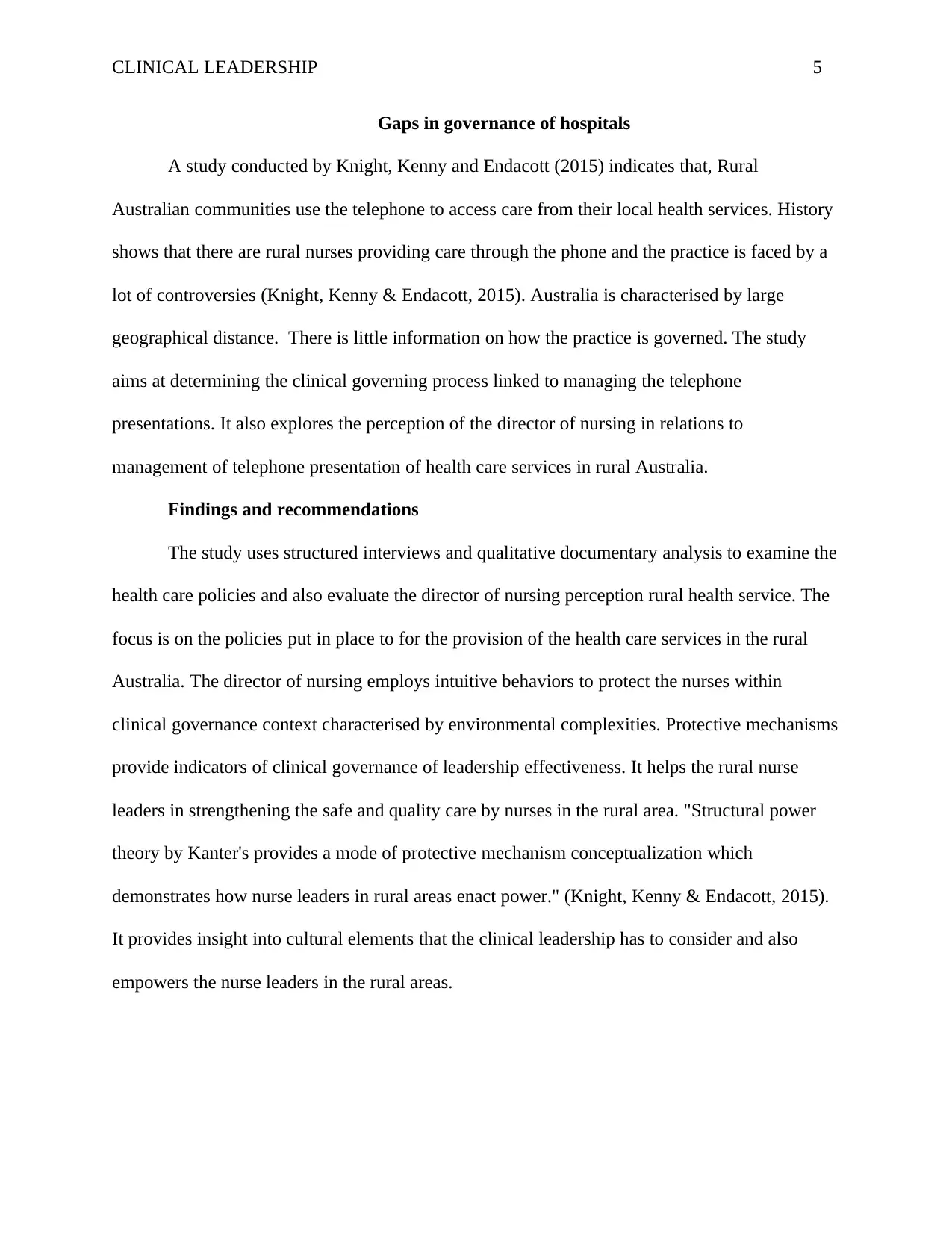
CLINICAL LEADERSHIP 5
Gaps in governance of hospitals
A study conducted by Knight, Kenny and Endacott (2015) indicates that, Rural
Australian communities use the telephone to access care from their local health services. History
shows that there are rural nurses providing care through the phone and the practice is faced by a
lot of controversies (Knight, Kenny & Endacott, 2015). Australia is characterised by large
geographical distance. There is little information on how the practice is governed. The study
aims at determining the clinical governing process linked to managing the telephone
presentations. It also explores the perception of the director of nursing in relations to
management of telephone presentation of health care services in rural Australia.
Findings and recommendations
The study uses structured interviews and qualitative documentary analysis to examine the
health care policies and also evaluate the director of nursing perception rural health service. The
focus is on the policies put in place to for the provision of the health care services in the rural
Australia. The director of nursing employs intuitive behaviors to protect the nurses within
clinical governance context characterised by environmental complexities. Protective mechanisms
provide indicators of clinical governance of leadership effectiveness. It helps the rural nurse
leaders in strengthening the safe and quality care by nurses in the rural area. "Structural power
theory by Kanter's provides a mode of protective mechanism conceptualization which
demonstrates how nurse leaders in rural areas enact power." (Knight, Kenny & Endacott, 2015).
It provides insight into cultural elements that the clinical leadership has to consider and also
empowers the nurse leaders in the rural areas.
Gaps in governance of hospitals
A study conducted by Knight, Kenny and Endacott (2015) indicates that, Rural
Australian communities use the telephone to access care from their local health services. History
shows that there are rural nurses providing care through the phone and the practice is faced by a
lot of controversies (Knight, Kenny & Endacott, 2015). Australia is characterised by large
geographical distance. There is little information on how the practice is governed. The study
aims at determining the clinical governing process linked to managing the telephone
presentations. It also explores the perception of the director of nursing in relations to
management of telephone presentation of health care services in rural Australia.
Findings and recommendations
The study uses structured interviews and qualitative documentary analysis to examine the
health care policies and also evaluate the director of nursing perception rural health service. The
focus is on the policies put in place to for the provision of the health care services in the rural
Australia. The director of nursing employs intuitive behaviors to protect the nurses within
clinical governance context characterised by environmental complexities. Protective mechanisms
provide indicators of clinical governance of leadership effectiveness. It helps the rural nurse
leaders in strengthening the safe and quality care by nurses in the rural area. "Structural power
theory by Kanter's provides a mode of protective mechanism conceptualization which
demonstrates how nurse leaders in rural areas enact power." (Knight, Kenny & Endacott, 2015).
It provides insight into cultural elements that the clinical leadership has to consider and also
empowers the nurse leaders in the rural areas.
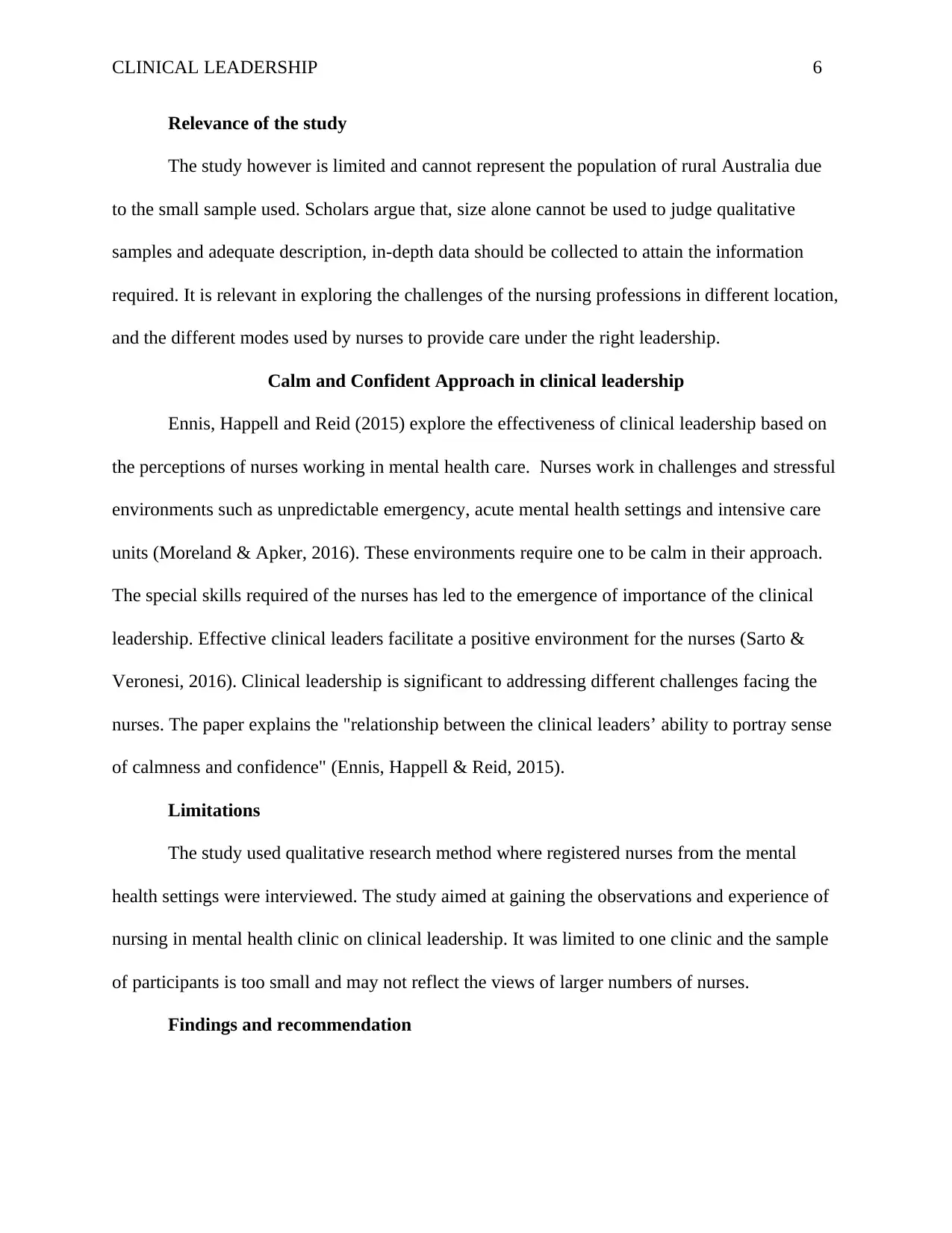
CLINICAL LEADERSHIP 6
Relevance of the study
The study however is limited and cannot represent the population of rural Australia due
to the small sample used. Scholars argue that, size alone cannot be used to judge qualitative
samples and adequate description, in-depth data should be collected to attain the information
required. It is relevant in exploring the challenges of the nursing professions in different location,
and the different modes used by nurses to provide care under the right leadership.
Calm and Confident Approach in clinical leadership
Ennis, Happell and Reid (2015) explore the effectiveness of clinical leadership based on
the perceptions of nurses working in mental health care. Nurses work in challenges and stressful
environments such as unpredictable emergency, acute mental health settings and intensive care
units (Moreland & Apker, 2016). These environments require one to be calm in their approach.
The special skills required of the nurses has led to the emergence of importance of the clinical
leadership. Effective clinical leaders facilitate a positive environment for the nurses (Sarto &
Veronesi, 2016). Clinical leadership is significant to addressing different challenges facing the
nurses. The paper explains the "relationship between the clinical leaders’ ability to portray sense
of calmness and confidence" (Ennis, Happell & Reid, 2015).
Limitations
The study used qualitative research method where registered nurses from the mental
health settings were interviewed. The study aimed at gaining the observations and experience of
nursing in mental health clinic on clinical leadership. It was limited to one clinic and the sample
of participants is too small and may not reflect the views of larger numbers of nurses.
Findings and recommendation
Relevance of the study
The study however is limited and cannot represent the population of rural Australia due
to the small sample used. Scholars argue that, size alone cannot be used to judge qualitative
samples and adequate description, in-depth data should be collected to attain the information
required. It is relevant in exploring the challenges of the nursing professions in different location,
and the different modes used by nurses to provide care under the right leadership.
Calm and Confident Approach in clinical leadership
Ennis, Happell and Reid (2015) explore the effectiveness of clinical leadership based on
the perceptions of nurses working in mental health care. Nurses work in challenges and stressful
environments such as unpredictable emergency, acute mental health settings and intensive care
units (Moreland & Apker, 2016). These environments require one to be calm in their approach.
The special skills required of the nurses has led to the emergence of importance of the clinical
leadership. Effective clinical leaders facilitate a positive environment for the nurses (Sarto &
Veronesi, 2016). Clinical leadership is significant to addressing different challenges facing the
nurses. The paper explains the "relationship between the clinical leaders’ ability to portray sense
of calmness and confidence" (Ennis, Happell & Reid, 2015).
Limitations
The study used qualitative research method where registered nurses from the mental
health settings were interviewed. The study aimed at gaining the observations and experience of
nursing in mental health clinic on clinical leadership. It was limited to one clinic and the sample
of participants is too small and may not reflect the views of larger numbers of nurses.
Findings and recommendation
⊘ This is a preview!⊘
Do you want full access?
Subscribe today to unlock all pages.

Trusted by 1+ million students worldwide
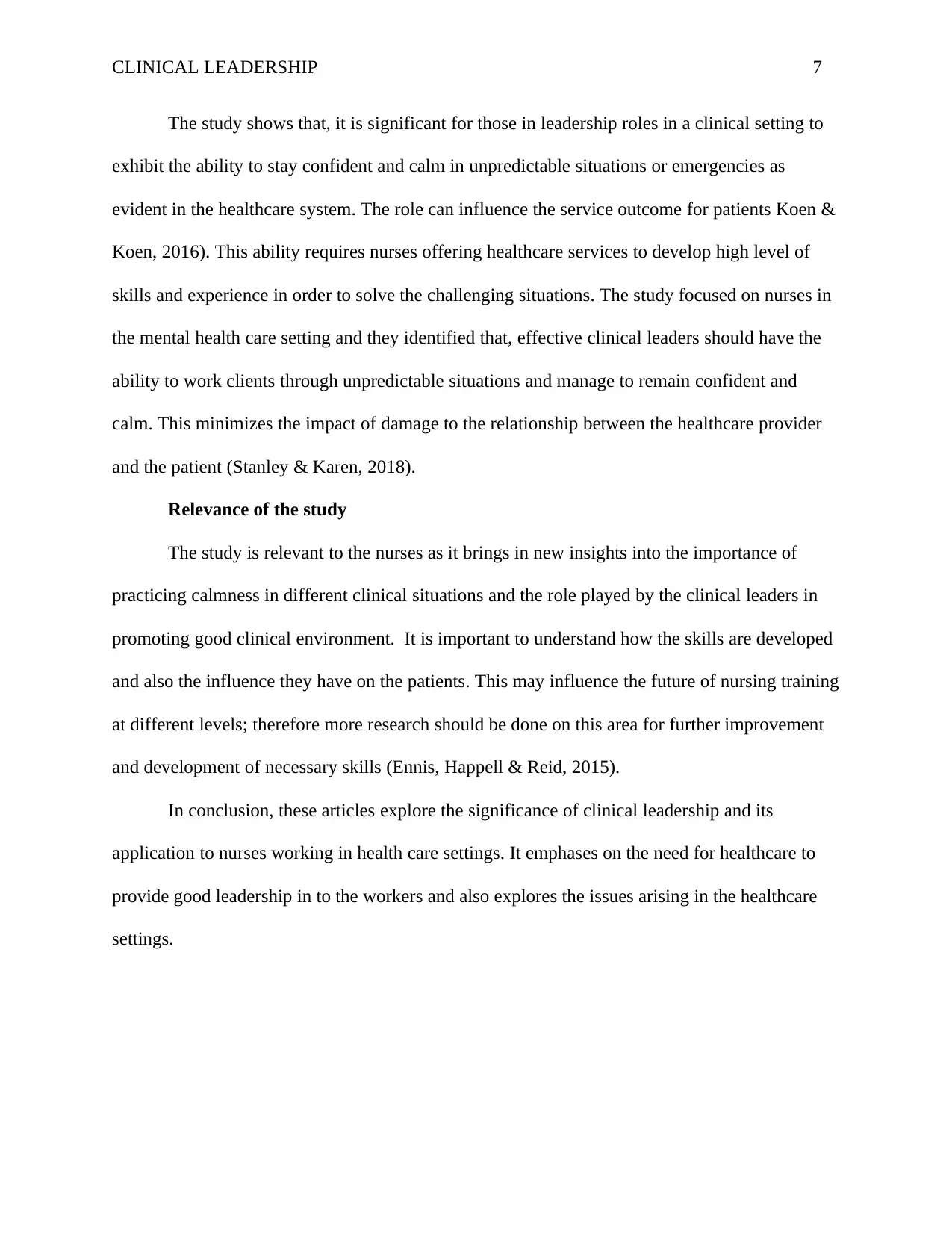
CLINICAL LEADERSHIP 7
The study shows that, it is significant for those in leadership roles in a clinical setting to
exhibit the ability to stay confident and calm in unpredictable situations or emergencies as
evident in the healthcare system. The role can influence the service outcome for patients Koen &
Koen, 2016). This ability requires nurses offering healthcare services to develop high level of
skills and experience in order to solve the challenging situations. The study focused on nurses in
the mental health care setting and they identified that, effective clinical leaders should have the
ability to work clients through unpredictable situations and manage to remain confident and
calm. This minimizes the impact of damage to the relationship between the healthcare provider
and the patient (Stanley & Karen, 2018).
Relevance of the study
The study is relevant to the nurses as it brings in new insights into the importance of
practicing calmness in different clinical situations and the role played by the clinical leaders in
promoting good clinical environment. It is important to understand how the skills are developed
and also the influence they have on the patients. This may influence the future of nursing training
at different levels; therefore more research should be done on this area for further improvement
and development of necessary skills (Ennis, Happell & Reid, 2015).
In conclusion, these articles explore the significance of clinical leadership and its
application to nurses working in health care settings. It emphases on the need for healthcare to
provide good leadership in to the workers and also explores the issues arising in the healthcare
settings.
The study shows that, it is significant for those in leadership roles in a clinical setting to
exhibit the ability to stay confident and calm in unpredictable situations or emergencies as
evident in the healthcare system. The role can influence the service outcome for patients Koen &
Koen, 2016). This ability requires nurses offering healthcare services to develop high level of
skills and experience in order to solve the challenging situations. The study focused on nurses in
the mental health care setting and they identified that, effective clinical leaders should have the
ability to work clients through unpredictable situations and manage to remain confident and
calm. This minimizes the impact of damage to the relationship between the healthcare provider
and the patient (Stanley & Karen, 2018).
Relevance of the study
The study is relevant to the nurses as it brings in new insights into the importance of
practicing calmness in different clinical situations and the role played by the clinical leaders in
promoting good clinical environment. It is important to understand how the skills are developed
and also the influence they have on the patients. This may influence the future of nursing training
at different levels; therefore more research should be done on this area for further improvement
and development of necessary skills (Ennis, Happell & Reid, 2015).
In conclusion, these articles explore the significance of clinical leadership and its
application to nurses working in health care settings. It emphases on the need for healthcare to
provide good leadership in to the workers and also explores the issues arising in the healthcare
settings.
Paraphrase This Document
Need a fresh take? Get an instant paraphrase of this document with our AI Paraphraser
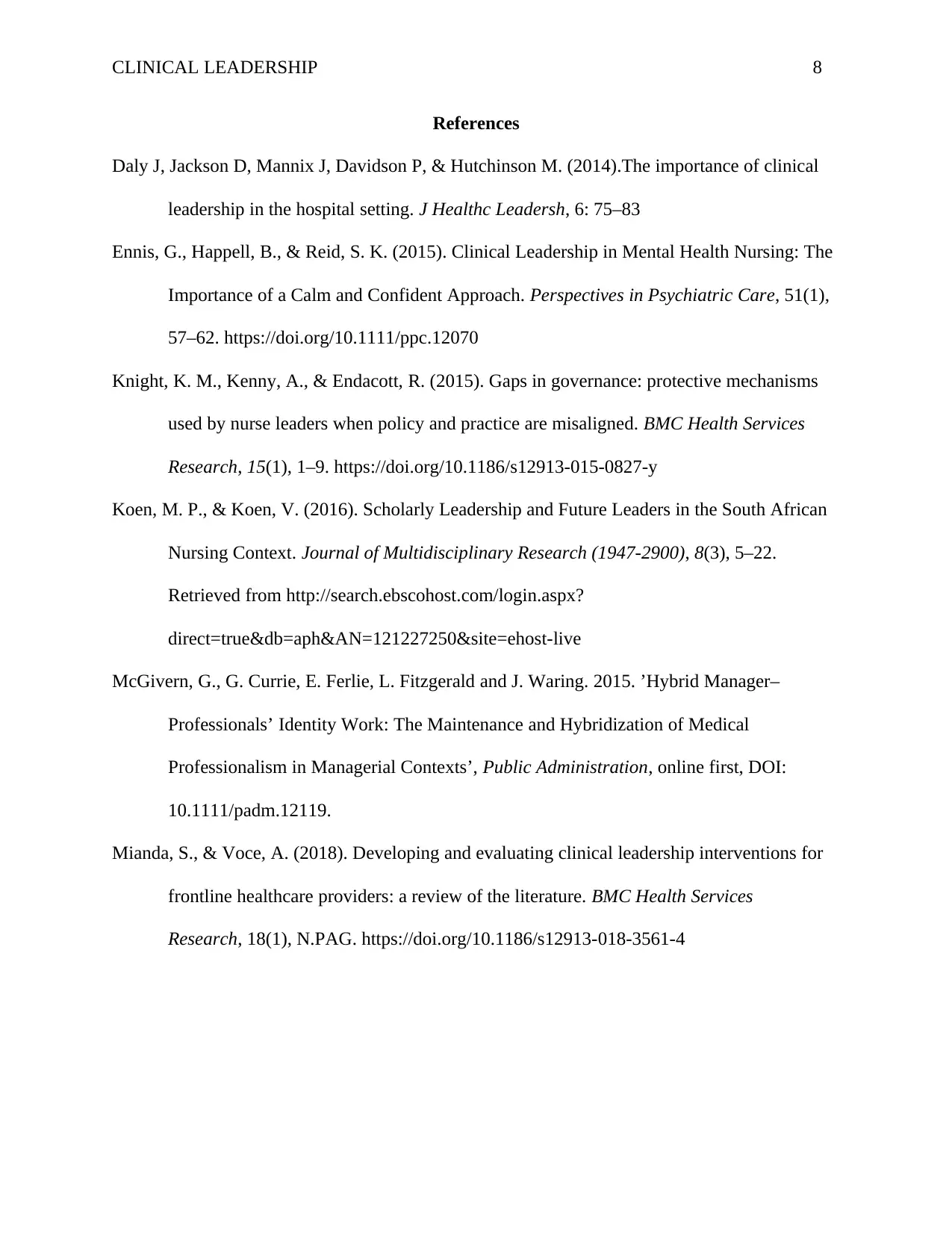
CLINICAL LEADERSHIP 8
References
Daly J, Jackson D, Mannix J, Davidson P, & Hutchinson M. (2014).The importance of clinical
leadership in the hospital setting. J Healthc Leadersh, 6: 75–83
Ennis, G., Happell, B., & Reid, S. K. (2015). Clinical Leadership in Mental Health Nursing: The
Importance of a Calm and Confident Approach. Perspectives in Psychiatric Care, 51(1),
57–62. https://doi.org/10.1111/ppc.12070
Knight, K. M., Kenny, A., & Endacott, R. (2015). Gaps in governance: protective mechanisms
used by nurse leaders when policy and practice are misaligned. BMC Health Services
Research, 15(1), 1–9. https://doi.org/10.1186/s12913-015-0827-y
Koen, M. P., & Koen, V. (2016). Scholarly Leadership and Future Leaders in the South African
Nursing Context. Journal of Multidisciplinary Research (1947-2900), 8(3), 5–22.
Retrieved from http://search.ebscohost.com/login.aspx?
direct=true&db=aph&AN=121227250&site=ehost-live
McGivern, G., G. Currie, E. Ferlie, L. Fitzgerald and J. Waring. 2015. ’Hybrid Manager–
Professionals’ Identity Work: The Maintenance and Hybridization of Medical
Professionalism in Managerial Contexts’, Public Administration, online first, DOI:
10.1111/padm.12119.
Mianda, S., & Voce, A. (2018). Developing and evaluating clinical leadership interventions for
frontline healthcare providers: a review of the literature. BMC Health Services
Research, 18(1), N.PAG. https://doi.org/10.1186/s12913-018-3561-4
References
Daly J, Jackson D, Mannix J, Davidson P, & Hutchinson M. (2014).The importance of clinical
leadership in the hospital setting. J Healthc Leadersh, 6: 75–83
Ennis, G., Happell, B., & Reid, S. K. (2015). Clinical Leadership in Mental Health Nursing: The
Importance of a Calm and Confident Approach. Perspectives in Psychiatric Care, 51(1),
57–62. https://doi.org/10.1111/ppc.12070
Knight, K. M., Kenny, A., & Endacott, R. (2015). Gaps in governance: protective mechanisms
used by nurse leaders when policy and practice are misaligned. BMC Health Services
Research, 15(1), 1–9. https://doi.org/10.1186/s12913-015-0827-y
Koen, M. P., & Koen, V. (2016). Scholarly Leadership and Future Leaders in the South African
Nursing Context. Journal of Multidisciplinary Research (1947-2900), 8(3), 5–22.
Retrieved from http://search.ebscohost.com/login.aspx?
direct=true&db=aph&AN=121227250&site=ehost-live
McGivern, G., G. Currie, E. Ferlie, L. Fitzgerald and J. Waring. 2015. ’Hybrid Manager–
Professionals’ Identity Work: The Maintenance and Hybridization of Medical
Professionalism in Managerial Contexts’, Public Administration, online first, DOI:
10.1111/padm.12119.
Mianda, S., & Voce, A. (2018). Developing and evaluating clinical leadership interventions for
frontline healthcare providers: a review of the literature. BMC Health Services
Research, 18(1), N.PAG. https://doi.org/10.1186/s12913-018-3561-4
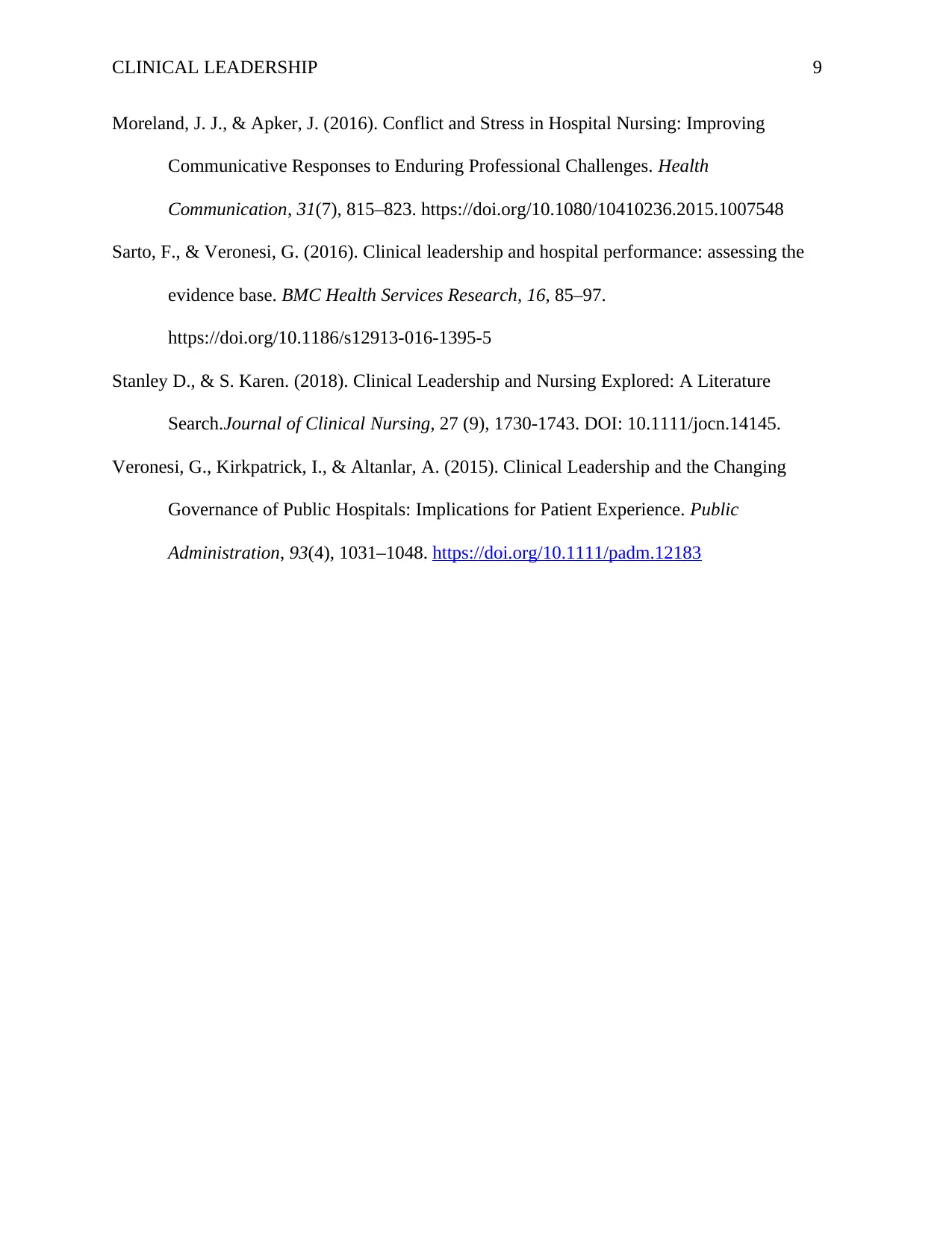
CLINICAL LEADERSHIP 9
Moreland, J. J., & Apker, J. (2016). Conflict and Stress in Hospital Nursing: Improving
Communicative Responses to Enduring Professional Challenges. Health
Communication, 31(7), 815–823. https://doi.org/10.1080/10410236.2015.1007548
Sarto, F., & Veronesi, G. (2016). Clinical leadership and hospital performance: assessing the
evidence base. BMC Health Services Research, 16, 85–97.
https://doi.org/10.1186/s12913-016-1395-5
Stanley D., & S. Karen. (2018). Clinical Leadership and Nursing Explored: A Literature
Search.Journal of Clinical Nursing, 27 (9), 1730-1743. DOI: 10.1111/jocn.14145.
Veronesi, G., Kirkpatrick, I., & Altanlar, A. (2015). Clinical Leadership and the Changing
Governance of Public Hospitals: Implications for Patient Experience. Public
Administration, 93(4), 1031–1048. https://doi.org/10.1111/padm.12183
Moreland, J. J., & Apker, J. (2016). Conflict and Stress in Hospital Nursing: Improving
Communicative Responses to Enduring Professional Challenges. Health
Communication, 31(7), 815–823. https://doi.org/10.1080/10410236.2015.1007548
Sarto, F., & Veronesi, G. (2016). Clinical leadership and hospital performance: assessing the
evidence base. BMC Health Services Research, 16, 85–97.
https://doi.org/10.1186/s12913-016-1395-5
Stanley D., & S. Karen. (2018). Clinical Leadership and Nursing Explored: A Literature
Search.Journal of Clinical Nursing, 27 (9), 1730-1743. DOI: 10.1111/jocn.14145.
Veronesi, G., Kirkpatrick, I., & Altanlar, A. (2015). Clinical Leadership and the Changing
Governance of Public Hospitals: Implications for Patient Experience. Public
Administration, 93(4), 1031–1048. https://doi.org/10.1111/padm.12183
⊘ This is a preview!⊘
Do you want full access?
Subscribe today to unlock all pages.

Trusted by 1+ million students worldwide
1 out of 9
Related Documents
Your All-in-One AI-Powered Toolkit for Academic Success.
+13062052269
info@desklib.com
Available 24*7 on WhatsApp / Email
![[object Object]](/_next/static/media/star-bottom.7253800d.svg)
Unlock your academic potential
Copyright © 2020–2025 A2Z Services. All Rights Reserved. Developed and managed by ZUCOL.





